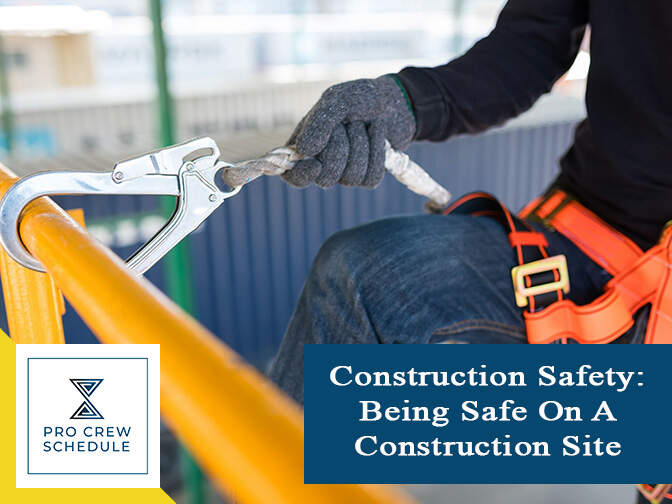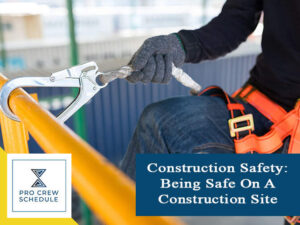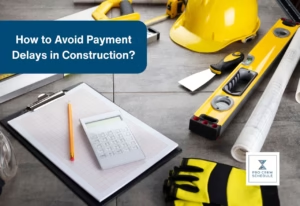Construction is a dangerous field to work in. Without responsible construction crew management, workers could end up with serious injuries or deaths from accidents. While accidents can occur at any time, especially given the industry’s nature, they can be somewhat avoided with proper safety management. Aside from handling the planning and supervising the entire project, a project manager for construction needs to look out for their staff’s safety.
In a report by OSHA (Occupational Safety and Health Administration), one in ten people who work on a construction site gets injured every year. In addition to that, there are about 150,000 accidents each year that happen on a construction site. However, general contracting can reduce the risk of accidents.
With the many factors that can cause accidents on a construction project, they can be avoided to some extent if the entire process progresses smoothly. A construction schedule software can keep the project manager, along with their staff, organized and efficient. There would be fewer materials and equipment scattered around the site that are hazardous. In fact, about 17% of fatal construction site accidents have something to do with objects– 11.1% by being struck by an object and 5.5% get stuck or caught up in one. With a structured crew schedule, there would be an ample amount of people working on a site, and accidents and injuries could be avoided.
Most Common Accidents That Happen On A Construction Site
Whether big or small, minor or fatal, accidents on a construction site are still accidents. These are five of the most common construction accidents so that you know what to avoid.
1. Falling
The most significant cause of accidents on a construction site is falling, which accounts for 33.5% of construction worker fatalities. Since construction work involves a lot of climbing, workers can fall off the building, from scaffolding, or even into ditches and holes. Even with safety harnesses, falling is still the leading cause of accidents.
2. Collapsed structure
A collapsed structure can cause harm in two ways. One, a structure a worker is on, like scaffolding or flooring, can collapse under their feet, taking the person with them. A fall like that from a high place and landing on rubble could give that person serious injuries. Or, a structure above the person could collapse, burying them alive. That collapse could crush them under, cut off their air supply, and kill them. Or, at the very least, injure them.
3. Electrocution
Because workers handle with generators, electrical wiring, power tools, and machinery, they work with electricity a lot. This gives them a higher risk of having an electricity-related accident. Electrocution has a range of effects, depending on the severity of the incident, from mild burns to death.
4. Improper work attire
Construction workers are required to wear a number of protective gear when entering the construction site, like hard hats, safety goggles, and gloves. These are to prevent injuries from occurring.
For example, because some crew members climb and work in higher places, there is a good chance that debris and other material could fall from above. Hardhats should be worn at all times to avoid head injuries from events like that.
5. Muscles strain
Much of construction work involves heavy lifting. Repeated strenuous work could damage a person’s soft tissues, muscles, and bones, causing them pain and limiting mobility. Commonly, workers get pain on their backs and necks. If immediately not treated or such activities are continued, the damages may be irreversible.
According to OSHA, 21% of the 4,779 worker deaths in 2018 were in the construction industry. However, not all accidents lead to fatalities. Some workers sustained severe injuries like:
● Burns;
● Broken bones;
● Strained muscles;
● Vision impairment from eye injuries;
● Injuries to the spinal cord; or
● Brain damage.
5 Tips For Improving Construction Site Safety
1. Be aware and communicate
No matter your level, ignorance can be a dangerous thing to have on a construction site. If you are unaware of the dangers of the site, you risk endangering the lives of yourself and the people around you. Before you can get to work, make sure you know and understand what you need to do and where to go to avoid causing accidents.
On the same note, project managers are responsible for letting their crew know everything that is happening on the site, including possible hazards and safety measurements.
This is where communication comes in. Managers and employees alike should be open to sharing their opinions and questions, especially on safety.
2. Supervise
Construction workers should know the ins and outs of the safety plan. But because they can be too caught up in their work, they sometimes fail to recognize what they should and shouldn’t be doing. That’s why construction managers need to be organized and be able to supervise. They should be alert and commanding to implement these measures.
3. Process documentation
Besides having every detail of the project on paper, managers need to go through legal processes prior to construction. This is to ensure that they conform to all safety regulations, both local and federal.
In addition to minimizing on-site accidents, proper paperwork can save the project from legal action and negative attention.
4. Wear and use proper equipment
As previously mentioned, everyone who steps foot on the site must be wearing the appropriate protective gear, not just the workers. Hardhats, especially, are essential when on-site because they protect all the people from falling debris and material, which is common in construction. Or, if a member working on electrical wiring refuses or forgets to wear gloves, they could suffer from electrical burns.
When it comes to equipment, the construction industry uses mostly heavy machinery and complicated power tools. People who are not equipped with the skill or knowledge of using these should attempt to try. Without proper training, unskilled workers could not only damage the project but harm other people, as well.
5. Keep up and change
If it were not for modern technology and innovative methods, construction sites would be more dangerous than they are today. So, even if upgraded machines and additional training would take a bit of the budget, it would be well worth it to change old methods and keep everyone protected.
The Four Pillars of a Safety Management System for Construction
The four pillars of a safety management system (SMS) were initially created for aviation. However, they are an excellent principle that can also be applied to construction. Primarily, these pillars guide senior management and the people responsible for safety to create and implement a safety program that is comprehensive and effective.
1. Safety policies and objectives
The first pillar is the foundation of an effective system: policies and objectives. Here, the SMS purpose is laid out and documented, along with a commitment from the company to stand by it. This pillar has four main elements:
a. Management commitment
The company will provide a statement of commitment to uphold the system, provide resources, follow procedures, and deliver information to the employees for safety.
b. Safety accountabilities
This document clearly defines the duties and responsibilities of each of the staff, managers, and employees alike. Included here also is the appointment of key personnel of safety.
c. Coordination of emergency
d. SMS documentation
All activities related to safety must be recorded and documented, and disseminated to the members.
2. Safety risk management
It’s crucial to stay ahead. So, this pillar is about identifying possible risks to be prepared for them. In a field like construction, where there is a high risk of danger, this pillar is essential.
The first step in risk management is hazard identification. This could take a lot of work, given the nature of the industry. Doing this, however, can give the project managers time to pre-emptively take measures to ensure their crew’s safety.
3. Safety assurance
In this pillar, the SMS is evaluated. As new information arises, the system should continuously be assessed and updated for improvement to adapt to upcoming challenges.
This step is necessary in a place like a construction site where there are constant developments and progress. When it comes to evaluation, the workers are the best people to get intel on as they are working on the ground and know what exactly happens there.
4. Safety promotion
The last pillar is where information dissemination takes into effect. All information regarding safety matters, including changes and updates, should be communicated to every member, both in management and the crew.
Additionally, the employees are expected to actively participate in all activities (such as training and education), invite others to follow, and provide feedback and constructive suggestions.
Key Takeaways
Construction is a dangerous industry to work in. The risk of accidents, injuries, and death is higher compared to any other industry. That’s why it is crucial to have a safety plan to ensure that everyone on site will be protected and secure.





